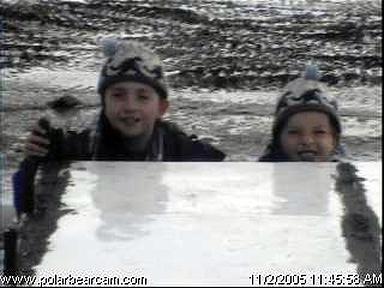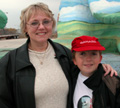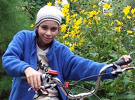Ridgecrest to Furnace Creek

Our favorite route into Death Valley is to leave the highway just past Trona and drive about 60 miles over dirt roads before we hit pavement again just south of Furnace Creek, the main settlement in Death Valley.
About 30 miles of this route requires a high-clearance four-wheel drive vehicle and crossing a rocky mountain pass, and even without the kids, Doug and I are not crazy enough to attempt this trip in the dark, especially without a full moon, so we drove first to Ridgecrest and spent the night so we could get a relatively early start in the morning.

We stopped at the Trona Pinnacles for the first time this trip, it's a little like visiting an alien landscape with the tufa spires rising suddenly and inexplicably from the desert floor.
Then a few miles on paved road to the Ballarat turnoff, marked by a sign which reads:
Now a ghost town, Ballarat served nearby mining camps from 1897 to 1917. They produced nearly a million in gold, the jail and a few adobe ruins remain. Seldom Seen Slim, it's last resident, was buried in Boot Hill in 1968. It had a school but no church.
Post Office Spring, 1/4 mile south is where the Brier Party, some Jay Hawkers and other '49ers came in their escape from Death Valley in 1850.
On Sunday morn at 3 am, March 22, 1908, a car in the world's longest race, a Thomas Flyer, arrived in Ballarat. It won the New York to Paris race, covering 13,341 miles in 169 days. The car is now in Harrah's museum in Reno.
We drove up Goler Wash, which starts out as a narrow canyon, up a dry waterfall and past several mines.

Goler Wash is full of abandoned mines. Rusting mining equipment and the remains of housing for the miners are plentiful.

We stopped at the Newman cabin, part of the abandoned Newman Mine.

Most of these cabins are relatively clean and well-maintained by passers-by. Sometimes we find people staying in the cabins, this time there was no one there so we went in.

Inside the cabin on a shelf was an empty box with an attached envelope containing a permit for the removal of the cremated remains of Ernest Leroy Hill, whose final wishes presumably were to have his ashes scattered in Goler canyon.

We have yet to make a trip to Death Valley that hasn't resulted in at least a small amount of damage to our car. We left a piece of our running board somewhere along our descent over two large rockfalls below Mengel Pass.

On the way up Mengel Pass, we encountered a man and his wife and son descending the pass, heading back toward Ballarat. They told us not to even bother trying to go over the pass, they'd attempted it and managed to go over the pass but turned back after encountering the first rockfall on the opposite side.
Doug took the man's warning as a personal challenge and we got out of the car at the rockfalls and moved rocks in an attempt to build a path that would protect our undercarriage, and we made it down.

We finally made it to the salt flats of Badwater, 282 feet below sea level. At 88 degrees, it was by far the coolest time we've walked out over the salt.

There's a sign way up on the cliffs above the Badwater parking area that marks sea level.

Then on to Furnace Creek and our campsite where we pitched our tent in blowing sand and an increasingly strong wind.
But walking around that evening and staring up at what seemed an impossible number of stars, the journey seemed worth the effort.
- Kathleen
Labels: death valley 2007




































0 Comments:
Post a Comment
<< Home